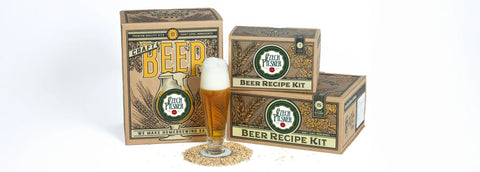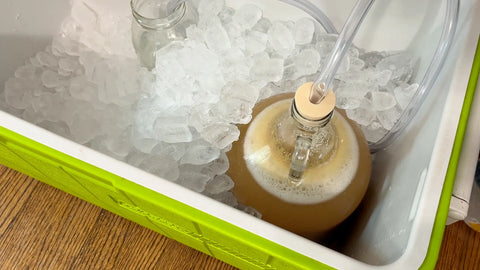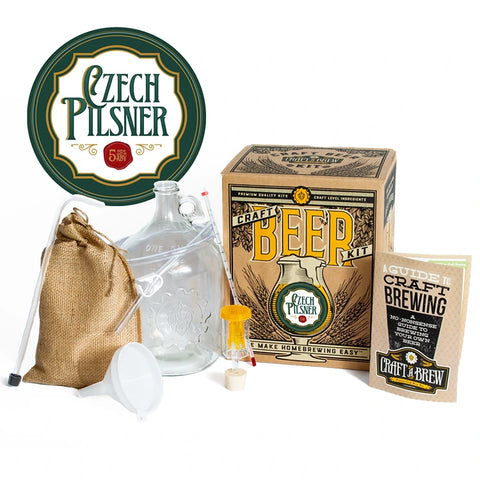How to Brew Czech Pilsner
TL;DR: Curious about how to brew Czech Pilsner at home? This crisp, golden lager is a favorite among beer lovers for its smooth malt character and spicy hop balance. Unlike ales, brewing Czech Pilsner requires cold fermentation, traditional Pilsner ingredients, and patience to achieve a clean, refreshing taste.
So, how do you make Pilsner? It all starts with the right ingredients—Bohemian Pilsner malt, Czech Saaz hops, and a cold-fermenting lager yeast—plus a controlled fermentation process that enhances clarity and flavor. While home Czech Pilsner brewing requires cooler temperatures, the results are well worth it.
Want to brew your own Czech Pilsner without the guesswork? The Craft a Brew Czech Pilsner Kit provides everything you need, from high-quality ingredients to step-by-step instructions for a smooth brewing experience.
This guide walks you through how to brew your own Czech Pilsner, covering everything from brewing techniques to fermentation, lagering, and bottling. Ready to craft a true Bohemian Pilsner at home? Let’s get started!
- Overview
- Download The Guide
- What You’ll Need to Make Pilsner
- Step-by-Step Pilsner Recipe
- Watch the Video
- Troubleshooting & Tips
- Customize Your Pilsner
Getting Started with Brewing a Czech Pilsner
If you've ever wondered how to brew Czech Pilsner, you're not alone. This classic beer style has been a favorite among lager lovers for centuries, known for its smooth, crisp taste and delicate balance of malt and hops. Whether you're an experienced homebrewer or just getting started, learning how to brew your own Czech Pilsner at home is a rewarding process that results in a truly refreshing beer.
So, how can I make Pilsner that captures the authentic flavors of a Bohemian lager? The secret lies in the Czech Pilsner brewing process—a combination of quality malts, traditional Saaz hops, and precise fermentation techniques. Unlike its German counterpart, Czech Pilsner is slightly fuller-bodied, with a richer malt character and a clean, spicy hop presence.
For those asking, "How do you make Pilsner at home?", the answer is simple: start with the right ingredients, use a reliable lager yeast, and control your fermentation temperatures. While brewing a Czech Pilsner at home requires patience, the result is a crisp, golden beer that showcases the beauty of classic European brewing traditions.
If you want to brew Czech Pilsner at home with ease, Craft a Brew’s Czech Pilsner Beer Recipe Kits provide everything you need to make an authentic Bohemian-style Pilsner. Available in both 1-gallon and 5-gallon sizes, these kits include premium malts, Czech Saaz hops, and a cold-fermenting lager yeast to guide you through the home Czech Pilsner brewing experience.
Ready to make Pilsner in your own kitchen? This step-by-step guide will walk you through how to brew Czech Pilsner at home, covering everything from selecting ingredients to fermentation and bottling. Let’s get started! 🍻
Download Our Guide to Making Pilsner
Ready to learn how to brew Czech Pilsners at home? Our comprehensive guide to making craft Pilsner will teach you how to lager a pilsner the right way. This guide to making Pilsner also includes tips for temperature control and clarifying your beer.
What You’ll Need To Make Pilsner
The key to brewing Czech Pilsner at home is selecting the right Pilsner ingredients, using the proper equipment, and mastering the Czech Pilsner brewing process. Whether you're crafting a 1-gallon batch for small-scale experimentation or stepping up to a 5-gallon recipe kit, having the right tools and ingredients will ensure a smooth brewing experience and a crisp, refreshing final beer.
Ingredients
Using the right Pilsner ingredients is crucial for brewing an authentic Czech Pilsner. The hallmark of this beer style is a deep golden color, a smooth malt body, and a balanced hop bitterness. Achieving this balance requires classic Bohemian malt, traditional Czech Saaz hops, a clean lager yeast, and mineral-rich brewing water.Our Czech Pilsner recipe uses a combination of Pilsner malt and specialty grains to create the signature golden color, crisp finish, and light caramel malt flavor:
- Pilsner Malt – The backbone of any Czech Pilsner, Pilsner malt provides a light, bready malt character and a crisp, clean body.
- Vienna Malt – A touch of Vienna malt enhances the beer’s color and adds a subtle, toasty sweetness without overpowering the balance.
Acidulated Malt – This specialty malt helps adjust mash pH for better fermentation and a smoother, more refined malt profile.
A defining characteristic of Czech Pilsners is their delicate balance of malt sweetness and hop bitterness. Unlike German Pilsners, which lean toward a drier and crisper profile, Czech Pilsners use Czech Saaz hops to achieve a rounded, slightly spicy, floral
One of the four original "Noble Hops," Saaz hops are essential for an authentic Czech Pilsner. They provide mild bitterness, floral and herbal notes, and a subtle spiciness that complements the malt backbone.
Unlike ales, Czech Pilsners are lagers, meaning they require a cold-fermenting yeast strain and precise temperature control. The yeast plays a crucial role in developing a clean and crisp flavor profile without fruity esters or overpowering yeast characteristics. Our Czech Pilsner Kit includes SafLager W-34/70, a classic lager strain ensures a clean, well-attenuated fermentation, allowing the malt and hops to shine while producing a crisp, smooth finish.
Water plays a critical role in home Czech Pilsner brewing, as authentic Bohemian lagers require soft, mineral-balanced water to achieve their signature smoothness. Since most tap water isn't naturally suited for brewing Czech Pilsner at home, we suggest using half distilled water and half filtered or spring water to most closely adhere to the style.
If you want to elevate your home Czech Pilsner brewing experience, consider fining agents and clarifiers to produce a crystal clear finished pilsner.
- Whirlfloc Tablets - Add a tablet to the boil to help sediment from brew day clump and settle out of suspension.
- Gelatin Finings - Use gelatin finings to further clarify a beer after fermentation.
Equipment
Brewing a Czech Pilsner requires many of the same tools used in ale brewing, but because lagers ferment at cooler temperatures, temperature control equipment is essential. Whether you’re using Craft a Brew’s 1-gallon Czech Pilsner making kit or brewing a 5-gallon batch, having the right tools will ensure a smooth fermentation and a crisp, clean beer.Your brew kettle should hold as close to a full gallon (or five gallons) of liquid as possible while leaving room to prevent boil overs. The pot’s lid will be used when chilling the wort before pitching yeast.
Maintaining precise temperatures is crucial for brewing Czech Pilsner at home. Our Czech Pilsner making kit includes a glass lab thermometer, but you can also use a digital food-safe thermometer. Key temperatures to monitor include:
- Steeping grains: 155ºF (68ºC)
- Chilling wort: Below 75ºF (23ºC) before pitching yeast
- Fermentation: 50-55ºF (10-13ºC) for primary fermentation
- Fermentation Temperature Control (Fridge, Chest Freezer, or Cooler Setup)
Unlike ales, Czech Pilsners are lagers and require cold fermentation. A dedicated temperature-controlled space is critical for proper fermentation and lagering. Some options include:
- A mini fridge or chest freezer with a temperature controller to maintain lager fermentation temps (50-55ºF).
- A temperature-controlled fermentation chamber to keep the beer at the ideal range.
- A cooler and ice packs, rotated frequently, can work for small-scale brewing if a fridge isn't available.
A funnel helps transfer the wort (unfermented beer) into the fermenter. A 4” funnel is included in our Czech Pilsner making kit for seamless transfer.
A glass carboy is included in our Czech Pilsner making kit as the primary fermenter, where lager yeast slowly transforms wort into beer. The rubber stopper seals the fermenter, allowing for controlled fermentation.
A racking cane is a rigid plastic tube used for transferring beer from the fermenter while leaving sediment behind. Using a siphon helps minimize oxidation and ensures a clean transfer into bottles or secondary fermentation.
During fermentation, an airlock allows CO2 to escape while preventing contamination. Lager fermentation produces fewer bubbles than ales, so don’t worry if it appears less active.
Once fermentation and lagering are complete, you’ll need to carbonate and package your beer. Options include:
- Flip-top bottles (like Grolsch-style swing tops)
- Pry-off bottles with a capper tool (if using standard beer bottles)
- Pre-measured priming sugar packets or carbonation drops for consistent bottle conditioning
Step-by-Step Brewing Guide
Brewing your first Czech Pilsner at home is easy with the Craft a Brew Czech Pilsner Making Kit. This step-by-step guide will walk you through the Czech Pilsner brewing process, from sanitizing your equipment to fermenting at cooler temperatures and bottling your crisp, golden lager. Follow along to brew Czech Pilsner at home with confidence!Step 1: Sanitize Everything
Before you begin brewing, proper sanitation is critical. Any bacteria or wild yeast can ruin your beer.
- Mix half of the included sanitizer packet with 1 gallon of water in a bucket or pitcher.
- Submerge all equipment that will touch the beer after boiling (fermenter, funnel, airlock, tubing, thermometer).
- Let everything soak for at least 60 seconds. No need to rinse—just let sanitized equipment air dry on clean paper towels.
Step 2: Heating the Water & Steeping the Grains
- Pour at least 2.5 gallons of water into your brew pot and heat until it reaches 155°F (68°C).
- While the water heats, place specialty grains in the grain steeping bag and tie off the top.
- Once the water reaches 155°F, steep the grains for 20 minutes, maintaining the temperature.
- Remove the grain bag and discard—do NOT squeeze (this releases tannins that can make the beer taste harsh).
Step 3: Boiling & Adding Malt Extract
- Increase the heat and bring the wort (unfermented beer) to a boil.
- Once the first boiling bubbles appear, remove the pot from heat and slowly stir in the Pilsen Malt Extract to prevent clumping.
- Return the pot to medium-high heat to maintain a gentle rolling boil.
Step 4: Hop Additions
Hops add bitterness, aroma, and flavor to your home-brewed Czech Pilsner. The Czech Pilsner beer kit includes authentic Czech Saaz hops to achieve the perfect spicy, floral balance. Start a timer for a 60 minute boil.
- At the start of the 60-minute boil, add Saaz Hops (Bittering).
- With 30 minutes left, add Saaz Hops (Flavor).
- With 10 minutes left, add Saaz Hops (Aroma).
- Pro Tip: Watch for boil-overs! If your wort foams up, turn off the heat and stir to prevent spills.
Step 5: Cooling the Wort
After boiling, the wort must be cooled as quickly as possible before fermentation can begin.
- Create an ice bath in your sink using ice and cold water.
- Place the pot in the ice bath and cover it with a lid to avoid contamination.
- Stir the surrounding ice water occasionally to speed up the cooling process.
- Use a sanitized thermometer to check that the wort is below 75°F (23°C).
- For advanced brewers: A wort chiller can speed up cooling time, reducing the risk of contamination.
Step 6: Transferring to the Fermenter & Pitching Yeast
Using a sanitized funnel, transfer the cooled wort into the sanitized fermenter, leaving any thick sediment (trub) behind.
- If needed, add cool water to reach a full 5-gallon volume.
- Aerate the wort by sealing the fermenter and rocking back and forth for a few minutes.
- Use sanitized scissors to open the W-34/70 lager yeast pack and pitch (add) the yeast to the wort.
Step 7: Setting Up Temperature Control & Monitoring Fermentation
Unlike ales, lagers ferment at cooler temperatures, so temperature control is key. Store the fermenter in a temperature-controlled space between 50-55°F (10-13°C).
Options for temperature control:
- Use a mini fridge or chest freezer with a thermostat.
- Keep the fermenter in a soft cooler or insulated bag with frozen water
- Monitor temps with an adhesive fermometer or a glass of water with a thermometer near the fermenter.
- Use a blow-off tube for the first few days to handle active fermentation. Once fermentation calms, swap it for an airlock filled with sanitized water.
Step 8: Optional Diacetyl Rest (Recommended for Smoother Flavor)
If fermenting at the lower end of the temperature range, we suggest raising the temperature to 70°F (21°C) on Day 10 for a diacetyl rest.
- Hold at 70°F for 4 days to allow the yeast to reabsorb diacetyl, a compound that can cause an unwanted buttery flavor.
- After the diacetyl rest, cool the beer back to 50-55°F for the remaining fermentation period.
Step 9: Optional Cold Crashing (For Better Clarity & Crispness)
To enhance clarity and crispness, cold crash your beer before bottling. Move the fermenter to a fridge or chest freezer and lower the temperature to 35-40°F for 3-5 days before bottling.
Step 10: Preparing Bottling Equipment & Priming Sugar
- Sanitize siphoning and bottling equipment (bottles, caps, siphon tubing, and bottling wand).
- In a pot, heat 2/3 cup of table sugar in 2 cups of water
- Stir until dissolved and boil for 5 minutes.
- Allow the priming solution to cool completely before using.
Step 11: Siphoning Beer into Bottles
- Place the fermenter on a high surface and the pot of priming sugar on the floor.
- Siphon the beer into the pot, carefully leaving sediment behind.
- Gently stir the beer to evenly mix in the priming sugar.
- Using sanitized tubing, siphon the beer into bottles, filling just to the neck. Cap the bottles.
Step 12: Bottle Conditioning & Lagering
- Carbonate at room temperature (65-70°F) for 2 weeks.
- After 14 days, move the bottles to a fridge or chest freezer for an additional 2-4 weeks of lagering at 35-40°F.
- The longer you lager (store at cold temps), the smoother and crisper your Czech Pilsner will be.
- Pro Tip: If your beer is under-carbonated, let it sit at room temperature for an additional 3-5 days before chilling.
After 2-4 weeks of lagering, your Czech Pilsner is ready to drink! Pour a glass, admire the golden clarity, and enjoy the crisp, refreshing taste of your homemade Bohemian lager.
Common Brewing Mistakes to Avoid
When brewing Czech Pilsner at home there are some unique ingredients and techniques required to produce this European lager style, including temperature control, lagering and proper water. To avoid messing up your first at-home Pilsner, get started with the Craft a Brew Czech Pilsner Beer Kit! This all-in-one kit provides everything you need to brew your own Czech Pilsner, including premium Pilsner malt extract, traditional Saaz hops, and authentic lager yeast. Plus, it includes step-by-step instructions to help you master the Czech Pilsner brewing process, even if it’s your first time making a lager.Here are some common mistakes brewers make when fermenting lagers and pilsners at home (and ways to avoid them)!✅ Keep your fermenter at 50-55°F (10-13°C) using a temperature-controlled fridge, chest freezer, or soft cooler with ice packs. Use a fermentation thermometer to monitor and maintain a stable temp throughout fermentation. If fermenting on the cooler end of the range, consider doing a diacetyl rest by raising the temperature to 70°F on Day 10 to allow the yeast to clean up off-flavors before bottling.
✅ Always use a proper lager yeast, like W-34/70, which is included in the Craft a Brew Czech Pilsner Beer Kit. Keep yeast healthy by properly aerating your wort before pitching. If you’re fermenting at the cooler end of the range, consider using a yeast starter to ensure full attenuation.
✅ Use 50% distilled or reverse osmosis (RO) water and 50% filtered or spring water to recreate a traditional water profile for your pilsner.
Tips for Successful Homebrewing
With a Craft a Brew Honey Weizen Making Kit, you’ll be equipped with the best tools and ingredients to brew the best possible beer. As you begin your homebrewing journey, remember to prioritize these concepts and your homebrews will be successful.Fermentation temperature can make or break your Czech Pilsner, affecting both flavor development and yeast health. Avoid temperature swings, as they can cause off-flavors or a stalled fermentation. There’s a saying that “brewers make wort, but yeast make beer.” It’s true! Be sure to give yeast the optimal environment and your beer will be better for it.
Proper sanitation is one of the most important aspects of homebrewing. Any bacteria or wild yeast contamination can ruin your beer. Sanitize ALL equipment that touches your beer after the boil, including fermenters, airlocks, siphons, and bottles. Use a no-rinse sanitizer (like the one included in our Czech Pilsner Kit) for convenience. Always rinse out your siphon and tubing immediately after use to prevent buildup.
To become a better brewer, you must learn from past missteps and take pride in your improvements! The best way to monitor your progress and brew better beers is to log everything. Get yourself a simple brew journal and log everything from ingredients and their weights, to dates, temperatures, tasting notes and everything in between.
With a Craft a Brew Czech Pilsner making kit, you’ll be equipped with the best tools and ingredients to brew the best possible beer. As you begin your homebrewing journey, remember to prioritize these concepts and your homebrews will be successful.
Homebrewing FAQs
Here are some common Czech Pilsner making FAQs, tips & solutions to any problem you might have while brewing Czech Pilsner at home.Cold fermentation temperatures required of a PIlsner do a pretty good job of pulling sediment and haze out of the beer for a clear finished product. But you can do a few things to further clarify your beer, like using fining agents and/or cold crashing.
- Fining Agents – Add fining agents like Irish Moss, Whirlfloc, or gelatin during or after fermentation to help proteins and yeast settle, improving clarity.
Cold Crashing – Before bottling, chill your fermenter to around 35–40°F for 3–5 days. This causes yeast and other particulates to drop out of suspension, resulting in a clearer beer.
For the best flavor and yeast performance, ferment your Czech Pilsner according to the yeast you use. For instance, the Craft a Brew Czech Pilsner making kit uses SafLager W-34/70, which is a very flexible and forgiving yeast strain. It ferments best between 53 - 64 °, but can tolerate temperatures up to 72 °F without producing noticeable off-flavors.
A buttery taste in your Pilsner is likely caused by diacetyl, a natural byproduct of fermentation. Ale yeasts are able to naturally absorb this off-flavor because they ferment at warm temperatures, but lager yeasts are not able to do this without help from the brewer. Our Czech Pilsner includes instructions for performing a diacetly rest toward the end of the fermentation process. This involves allowing the fermentation temperature to gradually warm to help remove diacetly from the beer.
Customize Your Pilsner
If you want to put your own twist on a traditional Czech Pilsner while staying true to its crisp, clean lager character, here are three ways to customize your homebrewed Pilsner:Boost the ABV
For a stronger, fuller-bodied Czech Pilsner, consider brewing with Brewers Crystals. Adding a small amount of extra Pilsen malt extract or Brewer’s Crystals can subtly raise the ABV by 0.5–1% without altering the delicate balance of malt and hops. Just be sure to keep the hop bitterness in check so the beer remains well-balanced.Experiment with different lager yeasts
Every yeast strain will add a different character to a beer, whether it’s neutral, flavorful or drying. Every yeast strain will have a different fermentation temperature range, too! So if you live in a warmer environment try a more forgiving yeast strain that can tolerate warmer temperatures.Age on oak for barrel aged flavor
While not traditional, you can certainly add barrel aged flavor when brewing Czech Pilsner at home. Add an oak infusion spiral or simple oak chips for a flavor that tastes like you aged in a real barrel!Why Make Your Own Pilsner?
- It’s Easier Than You Think: Many people think brewing a lager is difficult, but with the right Czech Pilsner brewing kit, it’s actually simple and rewarding. The Craft a Brew Czech Pilsner Kit provides all the equipment, ingredients, and step-by-step instructions you need to brew your own Czech Pilsner with confidence. No prior brewing experience is required! The process is straightforward, and our kit includes pre-measured ingredients to take the guesswork out of brewing. Follow our Czech Pilsner brewing process and achieve a smooth, balanced lager at home.
- Complete Control Over Flavor & Style: Want a Czech Pilsner that’s extra crisp? Prefer a richer malt backbone? When you brew Czech Pilsner at home, you get to decide exactly how it tastes. You can adjust the lagering time, experiment with noble hop additions, or modify the water chemistry to create a beer that matches your personal preferences. Homebrewing allows you to tweak every aspect of the process, ensuring a home Czech Pilsner brewing experience that results in a perfectly crafted beer.
- The Joy of the Brewing Process: Brewing is part science, part art—and completely satisfying. There’s something special about watching your beer ferment, bottling your brew, and finally enjoying a glass of something you crafted yourself. If you’ve ever wondered, "how do I brew Czech Pilsner at home?", now is the time to start. Whether you’re making your first lager or refining your Czech Pilsner brewing process, the experience of homebrewing is just as rewarding as the final sip.
Simplify the Process with the Craft a Brew Pilsner Making Kit
Homebrewing doesn’t have to be complicated! Our Czech Pilsner starter kit simplifies the process, making it perfect for beginners and experienced brewers alike.






